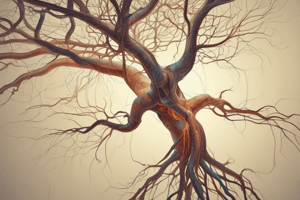Podcast
Questions and Answers
What are the two main structural divisions of the nervous system?
What are the two main structural divisions of the nervous system?
Central nervous system and peripheral nervous system
Which part of the brain is most closely associated with control of responses and decision-making?
Which part of the brain is most closely associated with control of responses and decision-making?
Frontal lobes
How many pairs of cranial nerves are there in the peripheral nervous system?
How many pairs of cranial nerves are there in the peripheral nervous system?
12
What is the functional division of the nervous system that includes functions of which we are aware?
What is the functional division of the nervous system that includes functions of which we are aware?
Which part of the autonomic nervous system regulates homeostasis?
Which part of the autonomic nervous system regulates homeostasis?
Study Notes
The Nervous System
- Every moment, the nervous system sends and receives countless messages about the body's internal and external environment.
Role of the Nervous System
- Coordinates all body activities
- Senses internal and external changes
- Interprets and processes information
- Responds accordingly to maintain homeostasis
- Enables complex human functions: intellect, emotion, behavior, memory, and learning
Structural Organization of the Nervous System
- Anatomical divisions: Central Nervous System (CNS) and Peripheral Nervous System (PNS)
- CNS: Brain and Spinal Cord
- PNS: 31 pairs of spinal nerves and 12 pairs of cranial nerves
- Functional divisions: Somatic Nervous System and Autonomic Nervous System
Central Nervous System (CNS)
- Brain: outer gray matter (cell bodies and unmyelinated axons), inner white matter (myelinated nerve axons)
- Spinal cord: inner gray matter (cell bodies), outer white matter (tracts)
Autonomic Nervous System
- Regulates body visceral function and internal environment (homeostasis)
- Two components: Sympathetic (prepares body for stress) and Parasympathetic (controls body at rest and during digestion)
Brain Components
- Cerebrum: largest part of the brain, divided into two hemispheres connected by the corpus callosum
- Cerebral cortex: outer layer of the cerebrum, composed of gray matter (nerve cells)
- White matter: inner layer of the cerebrum, composed of nerve fibers
- Four lobes: frontal, parietal, occipital, and temporal, each with specific functions that work together
Somatic Nervous System
- Carries information to and from the body, except for the intestines (autonomic function)
Studying That Suits You
Use AI to generate personalized quizzes and flashcards to suit your learning preferences.
Description
Explore the functions of the nervous system in sending, receiving, interpreting, and responding to messages about the body's internal and external environment. Learn how the nervous system senses changes, processes information, and adjusts the internal environment.




